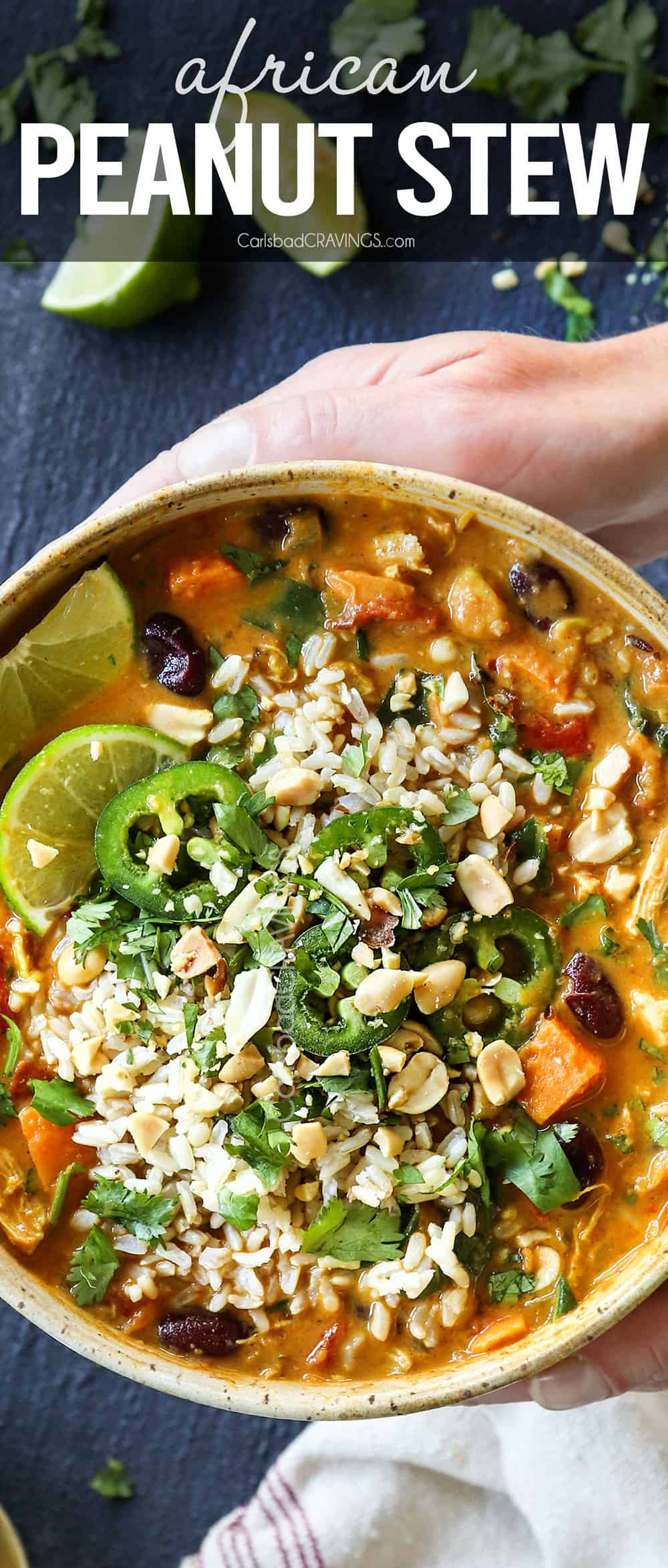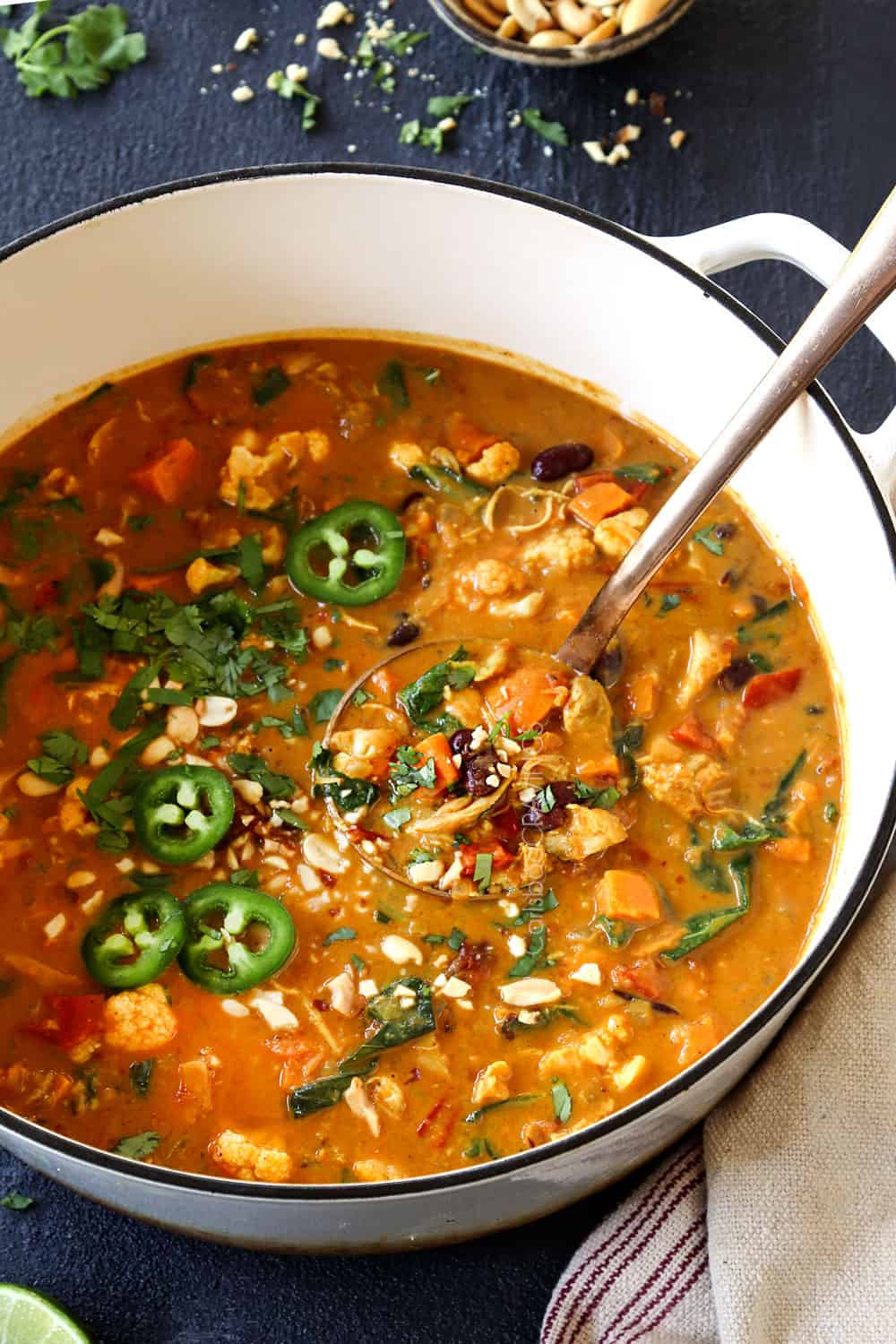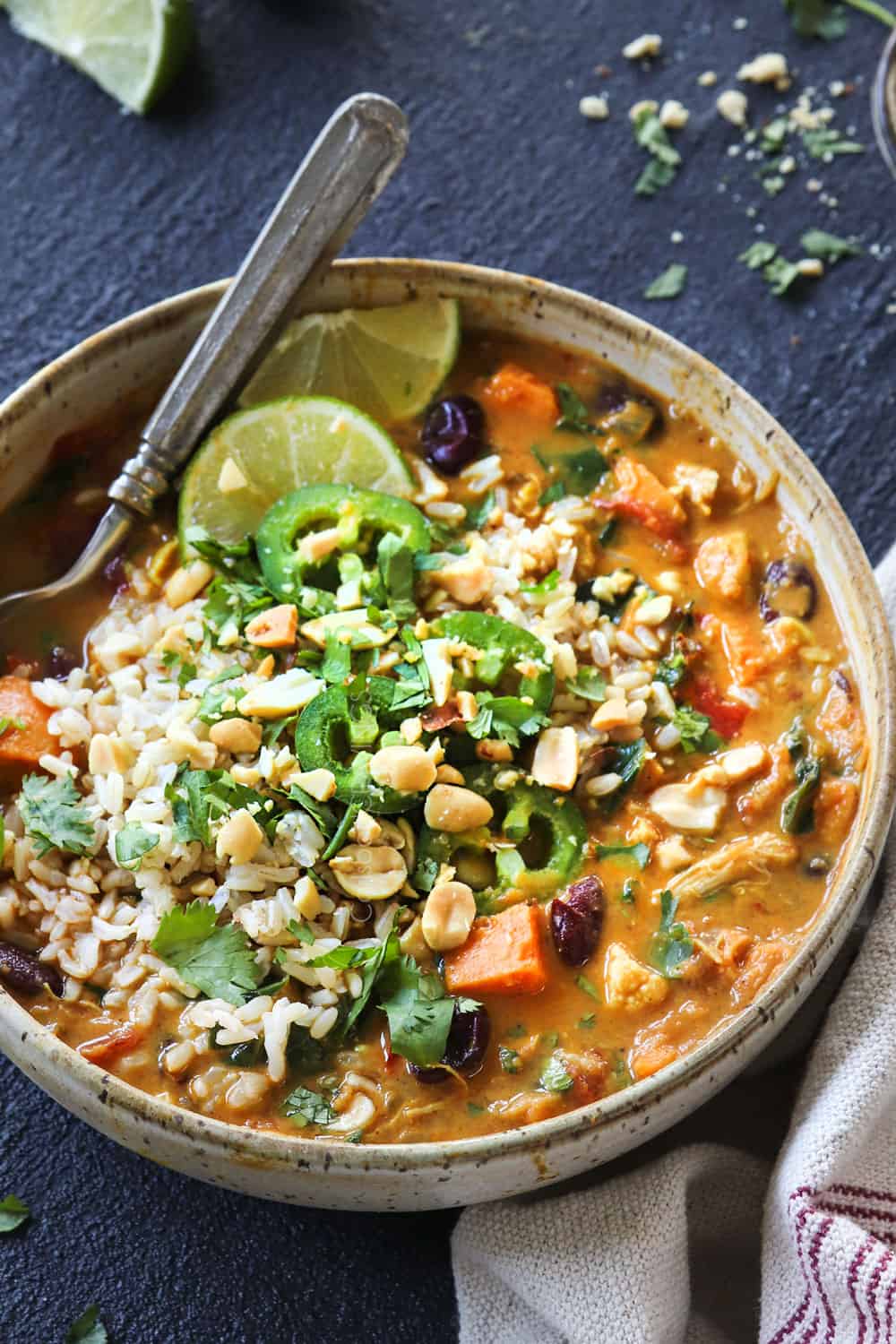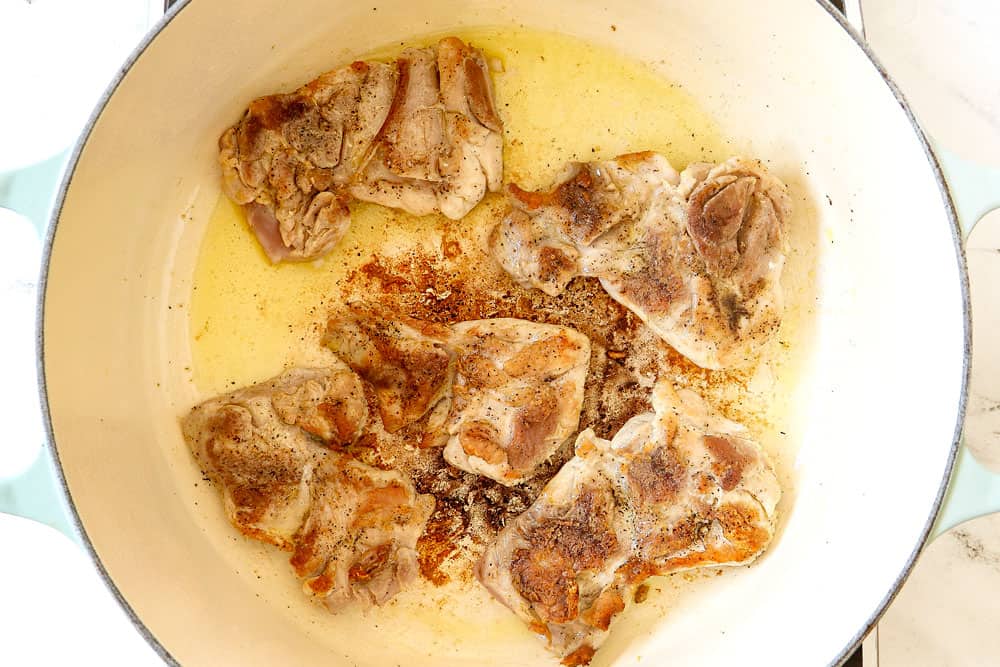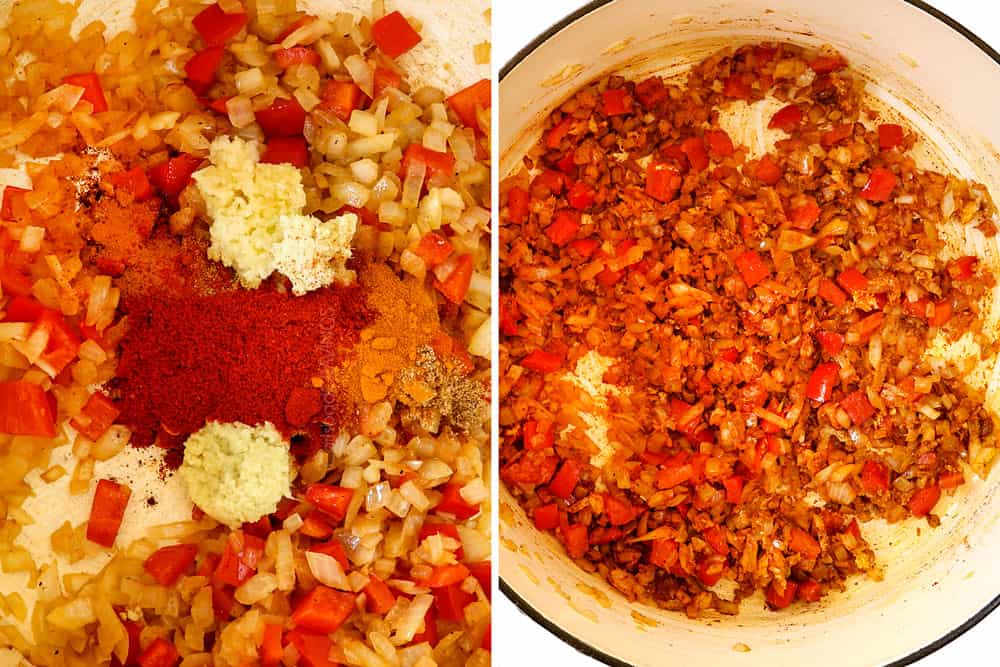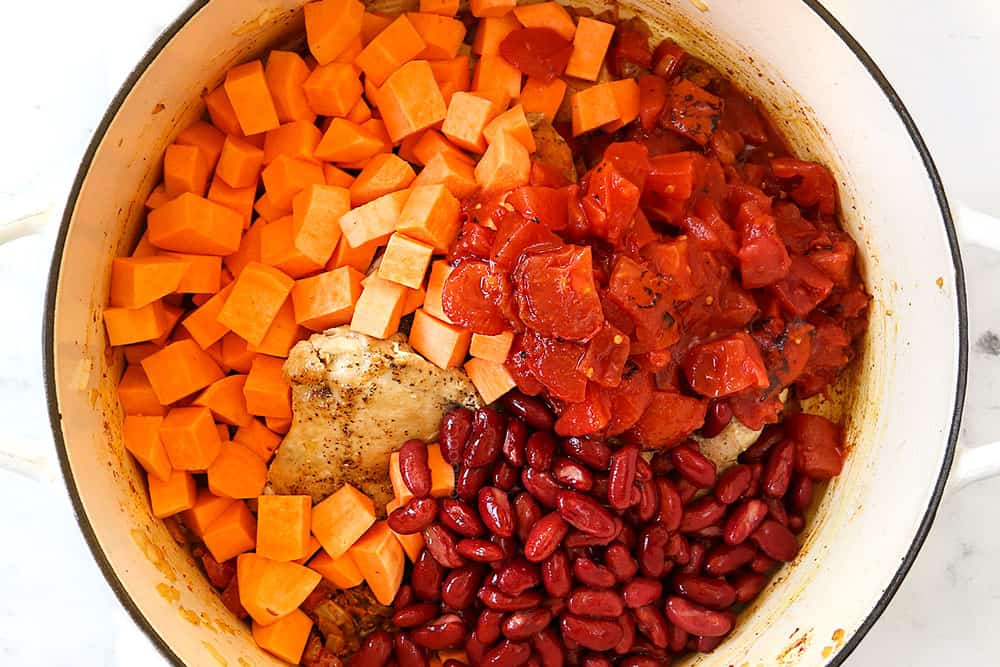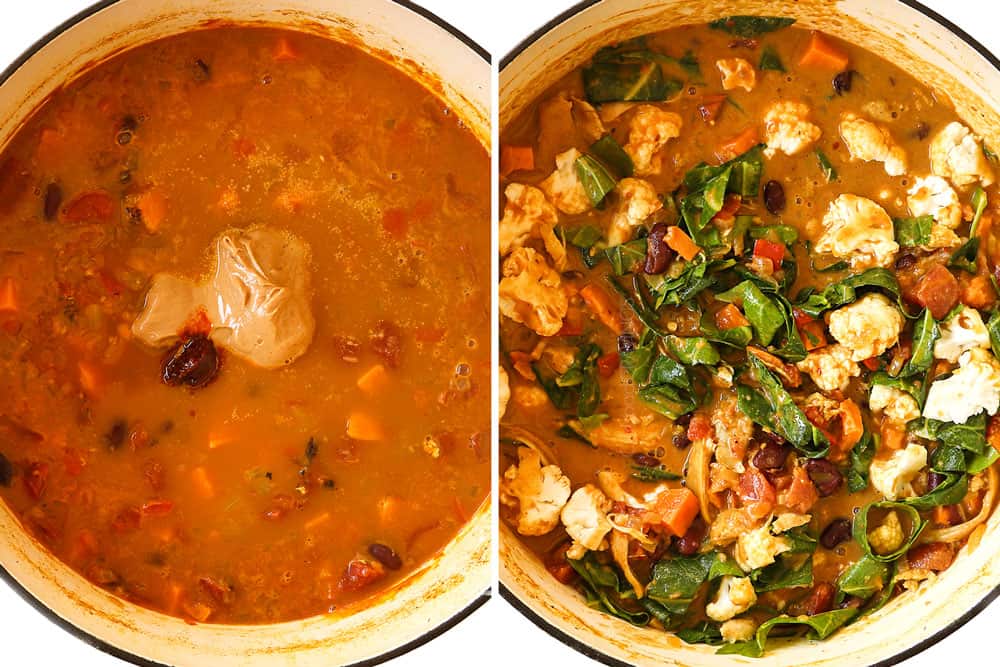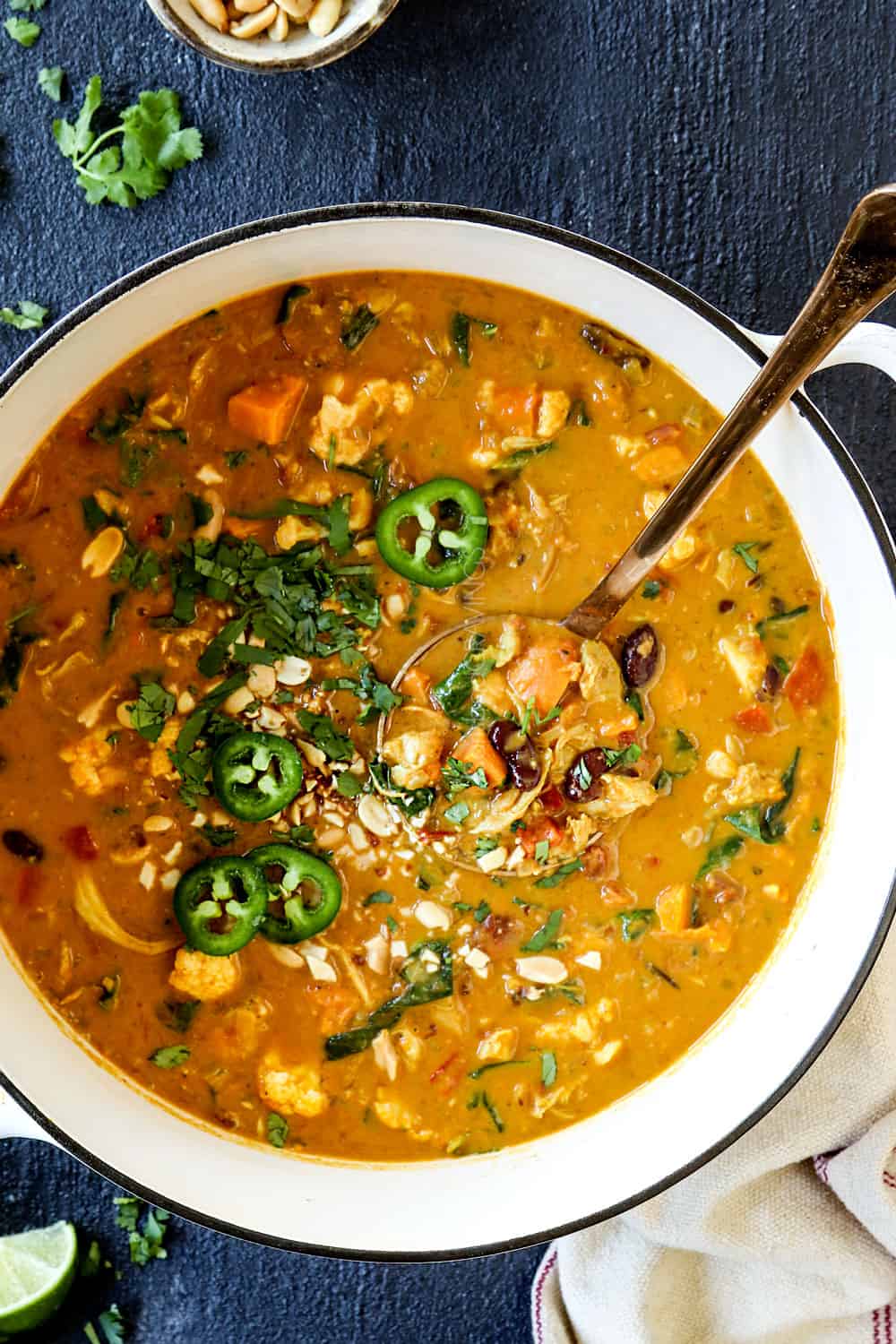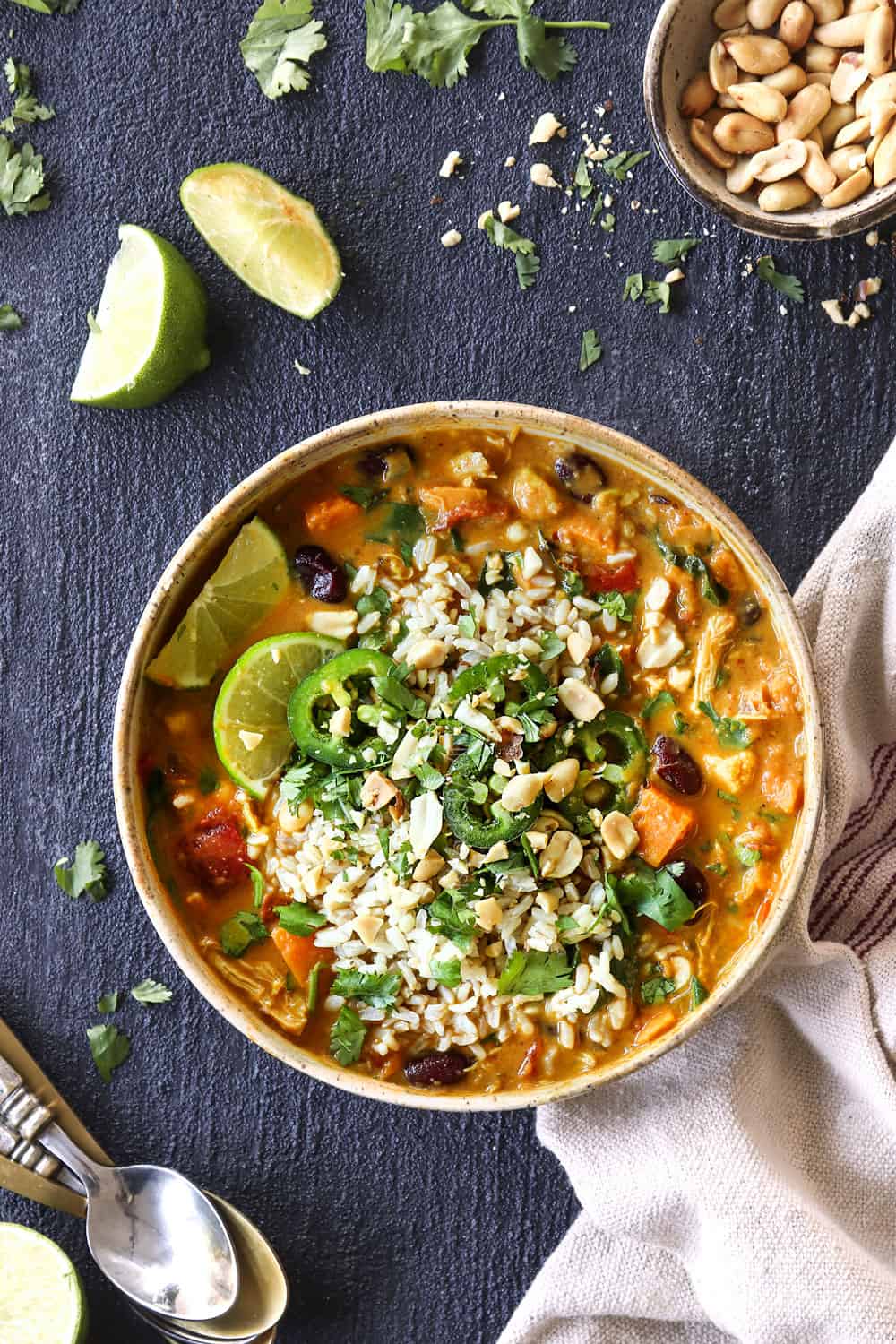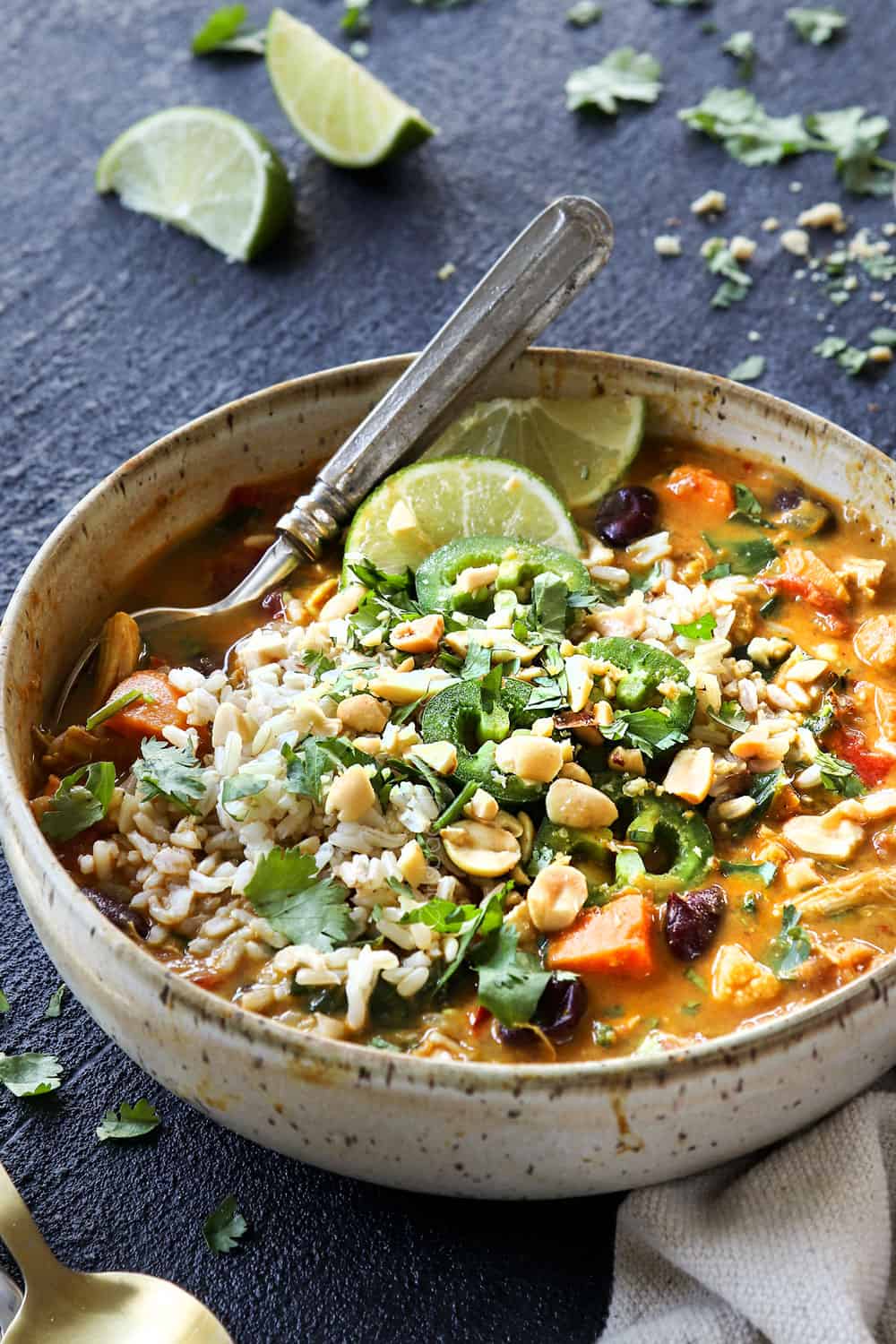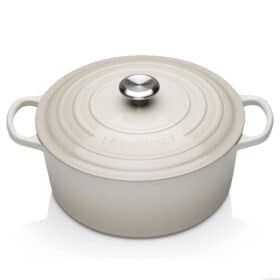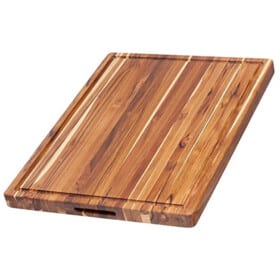Peanut based recipes are some of my absolutely favorites including this peanut butter soup! If you love peanut butter, don’t miss: Chicken Satay Skewers, Pineapple Coconut Chicken Satay, Thai Peanut Chicken Tacos, Thai Chicken Pizza, Peanut Butter Chicken (aka Chicken Satay Skillet) and Thai Peanut Noodles.
PIN THIS RECIPE TO SAVE FOR LATER
How to Make Peanut Soup Video
This African Peanut Stew recipe, also known as peanut soup, peanut butter soup or West African peanut stew, is inspired by the peanut stews popular in west African countries such as Mali (where it originated), Ghana, Senegal, Nigeria and Gambia, to name a few. In Africa, it is known as groundnut stew, granat soup, maafe, or domoda depending on the region and ingredients. These classic groundnut stew recipes vary from country to country, household to household, but they usually all include:
Ground peanuts Meat, typically chicken Tomatoes Chili peppers Fragrant spices
What’s in peanut soup?
You’ll find a variety of vegetables in peanut butter soup, depending on the region, but most versions include 1) some sort of root vegetable, sweet potatoes being the most common and 2) leafy greens, collard greens being the most common. African Peanut Stew can also include peppers, carrots, corn, okra, and cabbage. This recipe sticks to authentic sweet potatoes, bell peppers and collard greens with the addition of cauliflower for its fab texture. Some versions of peanut soup are soupier and served plain while others are thick stews, served over grains such as rice, millet or couscous, much like a curry. In Ghana they eat it with fufu, which is dough made from boiled cassava. This recipe falls somewhat in between but you can decide to make it soupier if you like by adding additional broth or thicker by adding additional peanut butter. West African Peanut Stew is typically spicy, topped with scotch bonnet peppers (a West African pepper), which are fiery hot! Scotch bonnet peppers are not for the faint of heart – they are about 40 times hotter than jalapeños. For this recipe, you decide how hot you want to make the soup. I’ve substituted the bonnet peppers with harissa paste, a common chili paste in Africa, or you can use cayenne pepper, chopped jalapenos, serrano or habanero peppers. No matter what you choose, please don’t skip the heat, it pairs beautifully with the sweet potatoes!
WHAT CHICKEN IS BEST?
I highly recommend chicken thighs (boneless or bone-in) for the best African Peanut Stew. Chicken thighs are dark meat which means they are inherently juicier, richer tasting and produce far more tender chicken than chicken breasts. They are also harder to overcook and stay tender for days with a more palate pleasing texture, even when reheated for leftovers. In addition, chicken thighs are browned first which adds an important layer of flavor to soup as all those golden, flavorful bits become part of the broth.
CAN I USE CHICKEN BREASTS?
Absolutely! You can still use chicken breasts in peanut butter soup, it’s just a matter of personal preference. Please note that because chicken breasts are leaner than chicken thighs, they will not be as juicy or as flavorful. If using chicken breasts, I suggest bone-in chicken breasts but boneless will also work. And make sure not to overcook!
african peanut soup ingredients
This African Peanut Soup has quite a few ingredients but they are easy to find and mostly just tossed into the pot – so please don’t be intimidated by the long list! This recipe is also extremely forgiving so feel free to swap in your favorite veggies. I’ve included recipe variations below. Here’s everything you’ll need:
THE SOUP
Peanut butter: the peanut in African PEANUT Stew! It adds a nutty earthiness and creaminess that marries all the ingredients together. You can use smooth OR crunchy peanut butter, both will be tasty. Chicken: I prefer using boneless skinless chicken thighs per above section or rotisserie chicken. Chicken broth: use low sodium broth so we can control the salt and make room for adding chicken bouillon, the secret flavor weapon. Chicken bouillon: is a secret ingredient that adds a rich depth of flavor that makes the peanut soup taste like it’s been simmering for hours. You can use granulated chicken bouillon, chicken bouillon cubes or better than bouillon. If using cubes, crush and add directly to the soup, don’t dissolve in water first. Fire roasted diced tomatoes: are tomatoes that have been roasted which gives them a complex smokiness and removes the acidic bite. Fire roasted tomatoes are located next to the traditional diced tomatoes – just make sure you purchase the ones without any added seasonings. You can use plain diced tomatoes if you can’t locate fire roasted. Kidney beans: rinsed and drained. Olive oil: use quality extra virgin olive oil for the best flavor.
THE AROMATICS AND SEASONINGS
Onion: one medium yellow onion or lazy day 1 ½ teaspoons onion powder. Garlic: use more or less garlic depending on how garlicky you want the stew. Fresh is best but you may also substitute with 1 to 1 ½ teaspoons garlic powder if you’re in a bind. Ginger: 1 tablespoon freshly grated or you may substitute with 1 teaspoon ground ginger if you’re out. I like to freeze ginger so it’s always at my fingertips. To freeze ginger: grate it, spread it by the teaspoon or tablespoon on parchment paper and flash freeze until solid, about 1 hour. Transfer to an airtight container or plastic bag for up to 6 months. You can add frozen ginger directly to your peanut soup. Ground cumin: is warm, earthy, nutty, with a hint of both sweet and bitter and edge of citrus and pairs beautifully with the nutty African Peanut Soup. Smoked paprika: rich, mild, sweet, and smoky made from smoked pimento peppers dried over oak fires then crushed. It is not spicy, just flavorful. Please do NOT substitute smoked paprika with regular paprika – the smokiness is everything. You can find smoked paprika with the rest of the spices at your grocery store. I use it in ALL my Mexican recipes and Cajun recipes so I promise your purchase will not go to waste. Ground coriander: earthy, tart, and sweet with a citrus note. It comes from the seeds of the cilantro plant but its flavor is surprisingly different than cilantro leaves. Turmeric: earthy, slightly bitter and peppery. Just a little adds a complex dimension that pairs beautifully with the sweetness of the sweet potatoes. Cinnamon and nutmeg: just a dash of these warm spices amps up the exotic flavor.
THE VEGETABLES
Red bell pepper: red is the sweetest of the bell peppers and compliments the earthy seasonings. Sweet potatoes: sweet potatoes are a constant in African Peanut Stew and I consider them key in this dish. They help balance the earthy spices and heat. You’ll need about 1 pound which is roughly 2 medium sweet potatoes or one large; the weight doesn’t have to be exact. Chop the potatoes into about ½-inch pieces so they don’t take too long to cook. Collard greens: have long been a staple of African diets. Collard greens are originally from Greece then came to Africa by way of Morocco, and much later to the United States. If you aren’t familiar with collard greens, they are slightly bitter, but not quite as bitter as kale. When cooked, like in this peanut soup, the bitterness mellows and brings out a subtle earthiness. To prep the greens, cut along each side of the stem with a sharp knife to remove it. Next, stack the leaves and cut them into 1/2-inch wide strips. Transfer the leaves to a colander and thoroughly rinse. Cauliflower: is not a traditional ingredient but I’m a huge fan of the texture it brings to the stew.
THE HEAT
IS African peant stew gluten FREE?
Yes! If you stick to the ingredients in this recipe, then your peanut butter soup is gluten free.
HOW SPICY IS this african peanut soup?
African Peanut Soup is supposed to be on the spicy side, so you’ll want to add a little heat no matter how adverse to spice you are. The heat cuts through the richness of the stew and really makes the other flavors pop. That being said, this peanut soup can be as mild or as spicy as you’d like based how much harissa or cayenne pepper you add. Two teaspoons of the harissa brand I use is medium spicy but this can vary depending on the harissa and personal preference. If using cayenne, start with ½ teaspoon and add more to taste.
HOW TO MAKE african peanut stew
This African Peanut Stew is easy to make in one pot in less than 60 minutes despite the long list of ingredients -and it is SO worth it! Here is how to make it with step-by-step photos (full measurements in the recipe card at the bottom of the post):
Step 1: Sear chicken. Searing the chicken with salt and pepper creates richer, deeper flavor and seals in the juices. Sear the chicken until golden, about 2 minutes per side in a large Dutch oven. Remove the chicken to plate or cutting board to shred; we’ll add it back in later. Now we have the glorious golden chicken bits AKA flavor gold which will build the base of the soup. But we’re just getting started…
Step 2: Sauté the aromatics. Next, sauté the onions and bell pepper until the onions are softened. Caramelizing the onions and peppers sweetens and maximizes the flavor for the base. Add the garlic, ginger, cumin, paprika, coriander, turmeric, nutmeg and cinnamon and sauté for 1 minute. Sautéing the spices in oil is called “blooming the spices” which releases and amplifies their flavor.
Step 3: Add the soup ingredients and simmer. Add the chicken back to the pot along with sweet potatoes, tomatoes, chicken broth, bouillon, beans add bay leaf. Cover the soup to bring to a simmer, then displace the lid so it’s partially covering the pot, with about a one-inch opening. Simmer the soup for 12-15 minutes or until chicken is tender enough to shred.
Step 4: Shred the chicken. Once the chicken is tender, remove it to a cutting board and shred with two forks. Meanwhile continue to simmer the soup IF the potatoes aren’t tender yet. We want them barely tender because they will continue to simmer another 5 minutes when we add the rest of the ingredients.
Step 5: Add peanut butter and remaining soup ingredients. Stir in the peanut butter and harissa or cayenne pepper to taste. Add the shredded chicken, collard greens and cauliflower and cook another 3-5 minutes, until the leaves are tender.
Step 6: Serve! Serve in bowls with cooked rice, cilantro, crushed peanuts and lime juice.
HOW TO SERVE african peanut soup
Just like pozole is known for its toppings, so is African Peanut Stew. Make the flavors come alive with:
Peanuts: add that coveted nutty crunch. Lime juice: awakens the flavors of the entire stew and cuts through the richness. Cilantro: adds a fresh, zesty flair.
what sides to SERVE WITH african peanut stew?
Grains: just belongs with the peanut soup. It adds a neutral textural pleasing component much like pairing curry with rice. My carb of choice is brown rice which is added directly to a bowl with the stew. White rice, (jasmine or basmati), quinoa, farro, lentils, etc. would also be tasty. Bread: some type of flatbread such as naan would be delicious for mopping up every last drop of peanut sauce. Salad: if you’d like to add a salad, beet salad, apple salad or fall salad are extra delish. Fruit: I also suggest some sort of fruit to compliment the rich, nutty flavors of the stew. Go simple with mangos or pineapple or we especially love pina colada fruit salad, fruit salad with honey lime vinaigrette or winter fruit salad.
TIPS FOR MAKING peanut butter soup
This peanut butter soup recipe is pretty straightforward, but here are some helpful tips to make it the best every time:
Don’t skip the sear. Searing the chicken results in the Maillard reaction, in which amino acids and reducing sugars produce browning, and as we know, color= flavor! The delicious brown bits left in the bottom of the pan will season the entire stew as they permeate the broth. Don’t burn drippings. Sear the chicken until golden but make sure it’s not at too high of heat. You don’t want any black specks because this will make the chicken stew taste burnt. If the chicken is browning too quickly, turn down the heat. Don’t overcook the chicken. Cook the chicken just until it easily shreds with two forks. This may take more or less time depending on the size of the chicken, simmering strength, pot, etc. If your chicken isn’t tender, cook on! Measure your spices first. Combine the spices first before you start cooking so you can dump them into the pot all at once so the they cook evenly and so the garlic doesn’t burn. Don’t overcook the sweet potatoes. If you overcook the potatoes then they will turn to mush – still tasty, just mush. The potatoes can take more or less time to cook depending on their size and actual simmering temperature so make sure you check them once you remove the chicken and then periodically after that if needed. Add the collard greens last. The greens should be tender but still bright and beautiful. They only need 3-5 minutes to cook. Customize consistency. This African Peanut Stew is on the thick and chunky side for a traditional soup. If you prefer it more brothy, simply add additional chicken broth. Don’t skimp the toppings! The peanut butters soup is rich and creamy and needs the brightness and textural contrast of the toppings. Once you season to taste with salt, add harissa or cayenne pepper and top with lime juice, peanuts and cilantro, then all the flavors will really pop.
peanut soup substitutions and VARIATIONS
This African Peanut Stew is fabulous as written or feel free to mix it up with different vegetables, protein, etc. etc.
Swap peanut butter. If you have a peanut allergy, then sunflower seed butter is probably the best substitute. You can also try cashew butter or almond butter but the flavor won’t be as good of a match. Use rotisserie chicken. Swap the chicken thighs for about 3 ½ cups shredded rotisserie chicken. Add the chicken to the soup when the recipe calls for adding the shredded chicken back to the pot. Swap protein. You can make African Peanut Soup with any protein! You can use chuck roast, pork shoulder, ground beef or ground turkey. Make it vegetarian. Omit the chicken and add extra vegetables in its place, extra beans, chickpeas, tofu or unripe jackfruit. If using jackfruit, add it with the sweet potatoes then lightly shred at the end of cooking. Make it vegan. Same as above and omit the chicken bouillon and swap the chicken broth for vegan broth. Make sure to season with additional salt to taste. Swap sweet potatoes. Sweet potatoes or yams are traditionally found in authentic African Stew for a reason, their sweetness is sublime with the rich, spicy stew, so I don’t suggest swapping. If you must, then you can swap for Yukon gold potatoes, parsnips or turnips. Swap beans. Swap the kidney beans for cannellini beans for their satisfying creaminess. Swap collard greens. I love the taste of collard greens in this recipe but any hearty greens will work. Use kale, mustard greens or Swiss chard. Personally, I don’t like spinach in this stew because it wilts too much. Swap vegetables. Add any of your favorite veggies such as butternut squash, green beans, carrots, corn, mushrooms, zucchini etc. Shorter cooking vegetables such as zucchini should be added with the cauliflower. Spice it up. If you don’t have harissa on hand, you can use cayenne pepper, sriracha or your favorite chili paste instead. Use spicy peppers. Instead of harissa, use jalapeno, serrano or Scotch Bonnet chili peppers. Make it creamier. Add up to ½ cup extra peanut butter for a total of 1 cup to make it ultra rich and creamy.
HOW MANY DAYS IS peanut butter soup GOOD FOR?
African Peanut Stew tastes even better the next day! It will last up to 5 days in an airtight container in the refrigerator or 3 months in the freezer.
HOW TO FREEZE african peanut soup
This African Peanut Stew freezes and reheats well. Here’s how:
Cool. Cool stew completely before freezing. Package: Add peanut soup to a freezer safe container. You can use sandwich size plastic bags for individual soup portions, quart size bags or freezer bags. To easy fill these bags, place them in a container that you can wrap the top around the edge of – for example, place a sandwich size bag in a mug then cuff the edges around the mug. This keeps the bag open and prevents it from collapsing when you are pouring in your stew. Final packaging tip, make sure to let out any excess air before you seal. Label. Make sure to label your bags so it the peanut butter soup doesn’t become a freezer mystery. You also want to label so you can be sure to use stew within 3 months. Freeze. Freeze the African Peanut Stew for up to 3 months. Once the bag is solid you can lay it flat in a single layer so it’s stackable to save space. Thaw/Reheat. The easiest way to thaw your stew is in the refrigerator overnight
HOW DO I REHEAT african peanut soup?
You can reheat this African Peanut Soup on the stove, in the microwave or crockpot:
Stove: reheat large batches on the stove over medium low heat, stirring occasionally – about 5-8 minutes. Microwave: transfer individual servings to a microwave-safe dish, and microwave for 90 seconds, stir, then continue to microwave for 20-second intervals, as needed.
HOW TO PREP peanut soup AHEAD
This African Peanut Stew does require a few steps but the upside is you can prep different components ahead of time.
Chicken: can be trimmed or trimmed and seasoned and stored in a single layer in an airtight container in the refrigerator for up to two days. Aromatics: onions, garlic and ginger can be prepped and stored in separate airtight containers in the refrigerator for up to 2 days. Veggies: bell peppers, sweet potatoes, cauliflower and collard greens can be chopped and stored in separate airtight containers in the refrigerator for up to 2 days. Spices: can be measured and stored in a sealable plastic bag until ready to use. Toppings: can be prepped a day ahead of time and stored in separate airtight containers in the refrigerator.
Tag @CarlsbadCravings and Use #CarlsbadCravngs Leave a Review, I Always Love Hearing From You!
